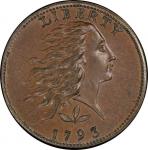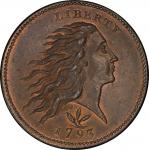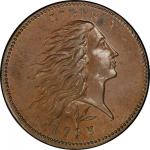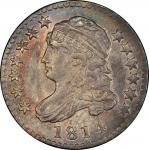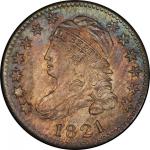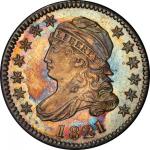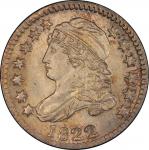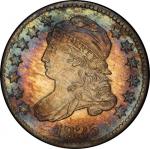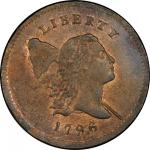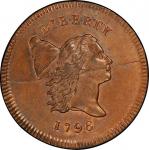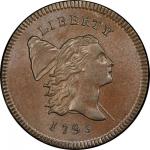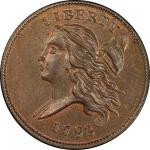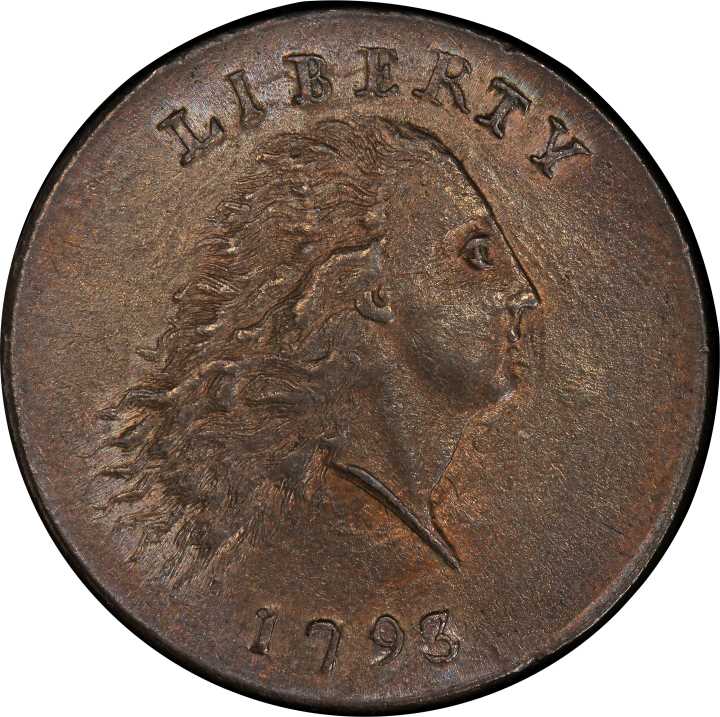1793美国飘发锁链版一美分 PCGS MS 65。“NUMISMATIC GOSSIP: We have in our possession a 1793 Chain cent without dot after legend and date, of original red color, sharply struck and perfectly uncirculated.” — Ed. Frossard, 1880 The finest known example from these dies and a candidate for the finest Chain cent of any variety, the Garrett-Pogue Sheldon-3 has been cherished by collectors since it was discovered in France by Pierre-Édouard LeGras, a famous Parisian numismatist who died in 1881. Since that time, this coin has been in several collections of legendary stature and quality. The surfaces do not show the mottled and blended patina that an RB designation might suggest, but instead display a splendidly mellowed and even tone of light steel, one that yields light blue and golden tones in one light, milk chocolate brown in another. Each perspective educes a corona of mint color around the portrait of Liberty and a rich burst of faded red from within the letters of LIBERTY above her.
Mint color is likewise preserved near the obverse rim, and capturing it in the right light will reveal an aurora of pastel tones. The spectacular reverse is more even, and a direct light produces a brightness approaching that of a fully red specimen. The cartwheel luster is complete and intense on both sides. The detail is likewise superb, showing each graver stroke in the hair, evoking the style of a folk artist’s skilled if unsophisticated decoration. The uneven texture of the die face and the luster-carrying flowlines of the reverse fields are revealed at this grade level, though with any wear they become lost. The process of studying a coin of this grade is like discovering a Chain cent for the first time, or at least understanding how these coins must have looked when they were first examined by the populace of Philadelphia in the spring of 1793. A significant rim surrounds the entire reverse, though it is both less prominent and less consistent around the obverse. No marks of any consequence are found, just a single thin hairline running nearly vertically in the left obverse field and a minuscule nick at the rim above the left serif of T in LIBERTY.
A hint of ancient encrustation remains in Liberty’s eye and among some intricacies of the chain. The obverse shows significant die clashing, with impressions from the chain links noticeable under the bust truncation, at the chin and lips, and faintly between the top of Liberty’s head and the legend above. The surrounding area of the die displays a buffet of flowlines and microscopic spalling under magnification, though the presence or absence of lapping is difficult to ascertain. Three of the four collectible Chain cent varieties are known with significant clashing, indicating issues with the press’s planchet feeding technology. It is unclear from the evidence just how die clashes were repaired in the earliest days of the Mint, or if they were repaired at all. Raised ripples in the die face radiate from the central obverse, surrounding the head of Liberty and visible among the letters of LIBERTY. Similar ridges are seen on the flowlined reverse, particularly near the bases of the letters of UNITED and below STATES. A light bulge above the space between UN of UNITED indicates an area of sinking in that part of the die. This piece was Breen’s plate coin for his die state III. Like the William Strickland coins that emerged from Nostell Priory in 1964 and 1992, the Garrett 1795 $10 that appears to have spent decades in Germany, and the Missouri Cabinet 1794 Cohen-7 half cent in the current sale, this coin’s earliest known owner was European, not American.
Perhaps because cents were an inexpensive and widely available denomination, they seem to have been preferentially saved by European visitors to the United States in the 18th century. For instance, five of the top seven best survivors of the Sheldon-14 Liberty Cap cent have provenance chains that begin in Europe, four of them in England. While the story of William Strickland’s visit to the United States is now well known, thanks to research by David Tripp first published in the Pogue Part II catalog, the stories of the Garrett-Pogue 1793 Chain cent’s voyage to Europe and its discovery there are, like most important American coins found overseas, shrouded in mystery. The first recorded owner of this coin, Pierre-Édouard LeGras, appears at the beginning of the provenance listings of several notable 1793 large cents, including the unique 1793 NC-5, the Eliasberg 1793 Sheldon-13 Liberty Cap cent, and the Garrett specimen of the same variety. He was born on March 9, 1803, or 18 Ventose An XI, in the then-prevailing French Revolutionary calendar. LeGras died on September 14, 1881. Following his passing, Paris auctioneer Charles Van Peteghem offered his collection in five sales between March 1882 and February 1883. United by a language and perhaps by friendship, LeGras and Ed. Frossard appear to have done considerable business; Frossard’s name follows that of LeGras in the provenance of every American large cent known to have been owned by the Parisian collector. While some LeGras cents were sold in the December 1882 sale after his death, this coin was purchased by Frossard while LeGras was still quite alive.
Frossard trumpeted its arrival in the United States for the first time in the May 1880 issue of his house organ, Numisma. “NUMISMATIC GOSSIP: We have in our possession a 1793 Chain cent without dot after legend and date, of original red color, sharply struck and perfectly uncirculated,” the notice read. In the next issue, dated July 1880, the coin was mentioned again, but this time it had been sold and was off the market: “1793 Chain cent without dot after legend or date; sharp impression, of original red color, perfectly uncirculated (sold) $100 00.” The purchaser, George M. Parsons of Columbus, Ohio, was one of Frossard’s best customers, though his name is today most associated with S. Hudson Chapman’s offering of his collection in 1914, long after his death. Parsons was a millionaire in the era of the Civil War; his daughter married a German prince. Parsons owned this coin for just a few years before his interest turned from standard issue United States coins and he became more deeply interested in early American medals. Frossard got it back in 1883, and he began to offer it to other well-heeled collectors. On May 23, 1883, Ed. Frossard penned a letter to T. Harrison Garrett to offer him “the cents, types only, of Honorable George M. Parsons, for whom I have been selling many coins at private sales during past years.” Parsons also owned the Sheldon-5 today known as “the Atwater Coin,” and it too was available: “there is a 1793 Wreath (No. 4 in the monograph), sharply struck, nearly Proof and bright red, just as it fell from the dies; also a chain 1793 nearly the same condition.” The Chain cent was, of course, this coin.
Frossard offered the Wreath to Garrett for $300 and this coin for $150, but even at those prices he “could not afford to sell unless a few of the others were taken, so as to assure me that I would come out whole.” Three weeks later, Frossard laid bait again, but at a less fancy price: “1793 chain and wreath, the two at $425; these are the property of Hon. George M. Parsons, and I quote his prices. It may please you to see them, even if you do not buy.” Garrett took Frossard up on his offer, inspecting them by mail before returning them. Garrett had just purchased a Wreath cent he liked perfectly well, but he lacked a high grade Chain cent. After acquiring the Ely Chain AMERI in January 1884, Garrett still had a space for a fine Chain AMERICA, so when this coin was offered at auction in 1885, he was ready. His local dealer and auction representative George Massamore wrote him on October 20, 1884. “Want to call your attention to the two 1793 cents in Frossard’s sale,” Dr. Massamore wrote. “They are the Parsons cents.” Massamore suggested bids of $100 for this coin and $150 for the red Wreath cent, cautioning “I may not get them at these prices but I think I can.” He collegially added “I would love to see you have these pieces in your collection.
It would be as much pleasure for me as it would for you.” The Wreath cent sold for $200 and ended up in the collection of Richard B. Winsor. Massamore was right on the money with this coin, landing it for his high bid of $100. It would not see auction again for nearly a century. After bringing $100 in 1884, this coin did not sell again until 1979, when its sale price of $115,000 set a new auction record for any regular issue United States copper coin. That record was not broken at auction until May 1996, when the Eliasberg-Pogue 1796 No Pole half cent brought $506,000. Large cent researcher and raconteur Bill Noyes, widely considered the most conservative keeper of large cent condition census information, has proclaimed this the finest known Chain cent. In his 1991 book on early dates, this was the only Chain cent he graded as a true MS-65, higher than the Parmelee-Pearl Sheldon-4 graded MS-66 BN by PCGS, the Sheldon-1 graded Specimen-65 BN by PCGS, and even “The Coin,” a Sheldon-4 graded Specimen-67 BN by PCGS. This is the only Chain cent at any grade level, Mint State or Specimen, to have been designated RB by PCGS. PCGS# 35439.1793 Flowing Hair Cent. Sheldon-3. Rarity-3-. Chain, AMERICA. No Periods. Mint State-65 RB (PCGS).

